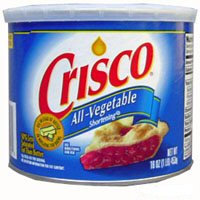Shortening
|
 |
Use shortening for the lightest and fluffiest cakes, cookies, and pastries. |
In general, the term shortening can apply to any oil- or fat-based ingredient – liquid or solid - used in baking. More specifically, recipes use the term to mean solid vegetable shortening rather than those made from animal fats (including lard, which is from pork).
Vegetable-based shortening is lower in saturated fats than butter. There are other advantages – shortening does not require refrigeration and does not burn when used for sautéeing. It’s a staple for many cooks and adds a light and fluffy texture to baked goods such as cakes and pie crusts.
Varieties
• Look for butter-flavored products. They will add extra flavor and can be used in the place of any regular vegetable shortening.
• Sticks are also available and are convenient for more exact measuring.
• Organic products are sold in health food stores. These will contain some saturated fats.
Buying Tips
• For frying, purchase “pure” shortening, which has a higher smoke point (and no additives).
• Read the labels – some products are higher in trans fats than others. If ingredients include “hydrogenated” or “partially hydrogenated” oils, there will be some saturated fat content.
Storage Tips
• Keep shortening away from heat sources, including the stove. A cool spot and tightly sealed container are recommended. For best freshness, use within a year after opening. It will keep up to two years unopened.
• At or near the end of shelf life, always sniff the container – discard if any odd (rancid) odor is detected.
• Shortening can be refrigerated or frozen (especially in warmer climates), but should be brought to room temperature before using.
Usage Tips
• Shortening should not be used in place of oils for salads, but it can be melted and used in many recipes.
• Shortening is less liquid than oils and butter. Just add extra water to the recipe.
• For increased flavor, include some butter and reduce the like amount of shortening.
Substitution Tips
• For dusting a cake pan, use cooking spray followed by a sprinkling of flour.
• Use butter or margarine in equal amounts (in some cases, plus a tablespoon or two).
Try one of our favorite shortening recipes:
Mile High Biscuits
French Donuts
Ken's Black Chocolate Cake






